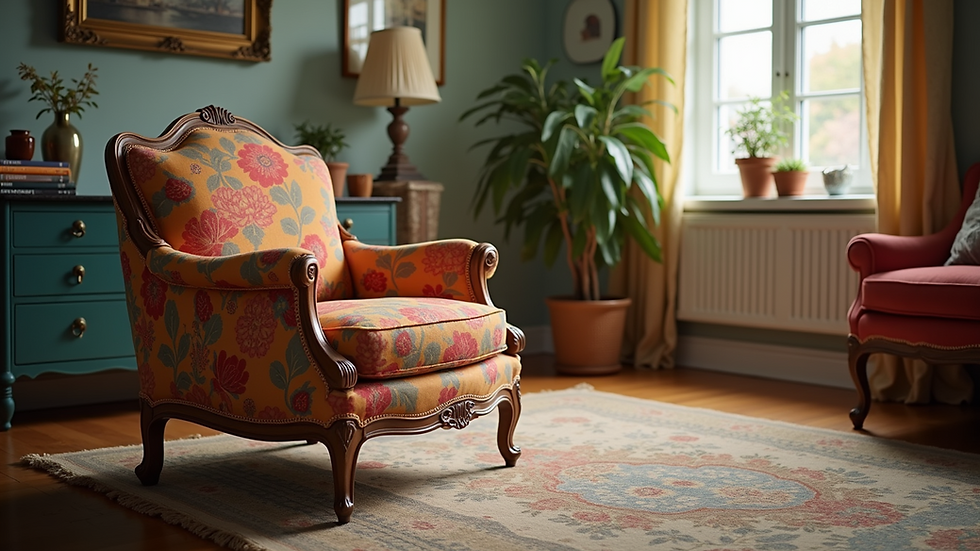Embracing Sustainable Living with Vintage Furniture
- Vintage-Furniture

- Sep 26
- 4 min read
Updated: Oct 6
The Allure of Vintage Furniture
Vintage furniture has a distinct charm that modern items often cannot replicate. Each piece carries a history that adds depth and character to your home. From a mid-century modern armchair to a chic 1960s coffee table, vintage items often serve as conversation starters, transforming any room into something memorable.
The appeal of vintage extends beyond nostalgia. Many of these pieces are made from high-quality materials, such as solid hardwood, which can last for generations. For example, a well-crafted oak dining table from the 1920s can often outlast cheaper, modern versions made from particle board. In fact, according to a study by the National Association of Home Builders, about 70% of vintage furniture still holds its structural integrity even decades after it was made. This makes these pieces a smart investment for sustainable living.
Refurbishing: Breathing New Life into Old Treasures
Refurbishing vintage furniture is a unique way to express personal creativity while minimizing waste. By giving old furniture a new lease on life, you not only maintain its history but also divert waste from landfills. Refurbishing can range from simple cleaning to extensive upgrades.
For instance, one might update a worn-out chair with fresh fabric and a bright coat of paint. This can enhance its appearance and make it fit the modern aesthetic of your home. Refurbished pieces often reflect your personal style and creativity, allowing you to transform dated designs into modern masterpieces.

Eco-Friendly Benefits of Vintage Furniture
Opting for vintage furniture is inherently eco-friendly and promotes a circular economy that values reuse and disposal. By choosing refurbished pieces, you help lessen landfill waste and reduce the carbon emissions associated with manufacturing new furniture.
Moreover, many vintage items are made from solid wood and other sustainable materials. Studies show that around 30% of modern furniture contains harmful chemicals and synthetic materials that can compromise indoor air quality. By selecting vintage furniture, you make a stylish choice that is not only aesthetically pleasing but also healthier for your living environment.
Unique Products: The Charm of Individuality
In a world filled with mass production, vintage furniture stands out as a unique alternative. Each piece has its quirks and imperfections, allowing homeowners to make a statement that mass-produced items cannot match.
Shopping for vintage is also an adventure. You can discover hidden gems at thrift stores, flea markets, and estate sales. This not only makes vintage furniture more affordable but also adds a sense of excitement to the hunt. For instance, a 1970s dresser might cost 50% less than a new equivalent—with the added benefit of exclusivity.
Tips for Finding and Refurbishing Vintage Furniture
If you’re stepping into the world of vintage furniture for the first time, consider these helpful tips:
Do Your Research: Learn about different styles and eras. Understanding what appeals to you will help in making better choices.
Inspect for Quality: Look for solid construction. Check for signs of damage or wear that may be difficult to repair.
Consider Functionality: Think about how the piece will fit into your space. Will it be a functional item or mainly decorative?
Get Creative with Refurbishing: Experiment with colours and finishes. A simple paint job can entirely change the look of an item.
Embrace Imperfections: The charm of vintage lies in its history. Celebrate the imperfections that have stories to tell.

Embracing a Sustainable Future with Vintage
The rise of eco-friendly refurbished vintage furniture is not just about aesthetics; it’s a vital step towards sustainable living that celebrates individuality and creativity. Selecting vintage pieces enriches your home while helping the planet.
As you explore the world of vintage furniture, remember that every piece possesses a unique story. Appreciate the charm of the past, contributing positively to the future. Whether breathing new life into a cherished family heirloom or unearthing a hidden treasure at a second-hand store, the possibilities are endless. Step into the world of vintage furniture—your home and the environment will surely benefit!
The Journey of Sustainable Living
Sustainable living is a journey, not a destination. It involves making conscious choices that reflect our values and beliefs. By choosing vintage furniture, we participate in a larger movement towards sustainability. Each piece we select is a step towards reducing our environmental footprint.
Incorporating vintage furniture into our homes allows us to create spaces that are not only beautiful but also meaningful. It’s about finding joy in the stories behind each item and the craftsmanship that has stood the test of time.
Conclusion: A Personal Invitation
I invite you to join me in this journey towards sustainable living. Embrace the charm of vintage furniture and the stories they carry. Let’s celebrate individuality and creativity while making choices that benefit our planet. Together, we can create homes that reflect our values and contribute to a brighter future.
Remember, every piece of vintage furniture has a story waiting to be told. Let’s give these treasures a new life and enjoy the beauty they bring to our homes.


